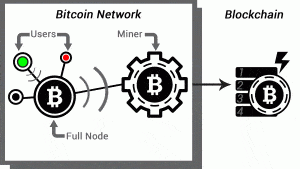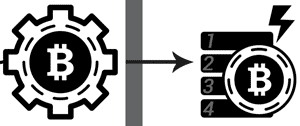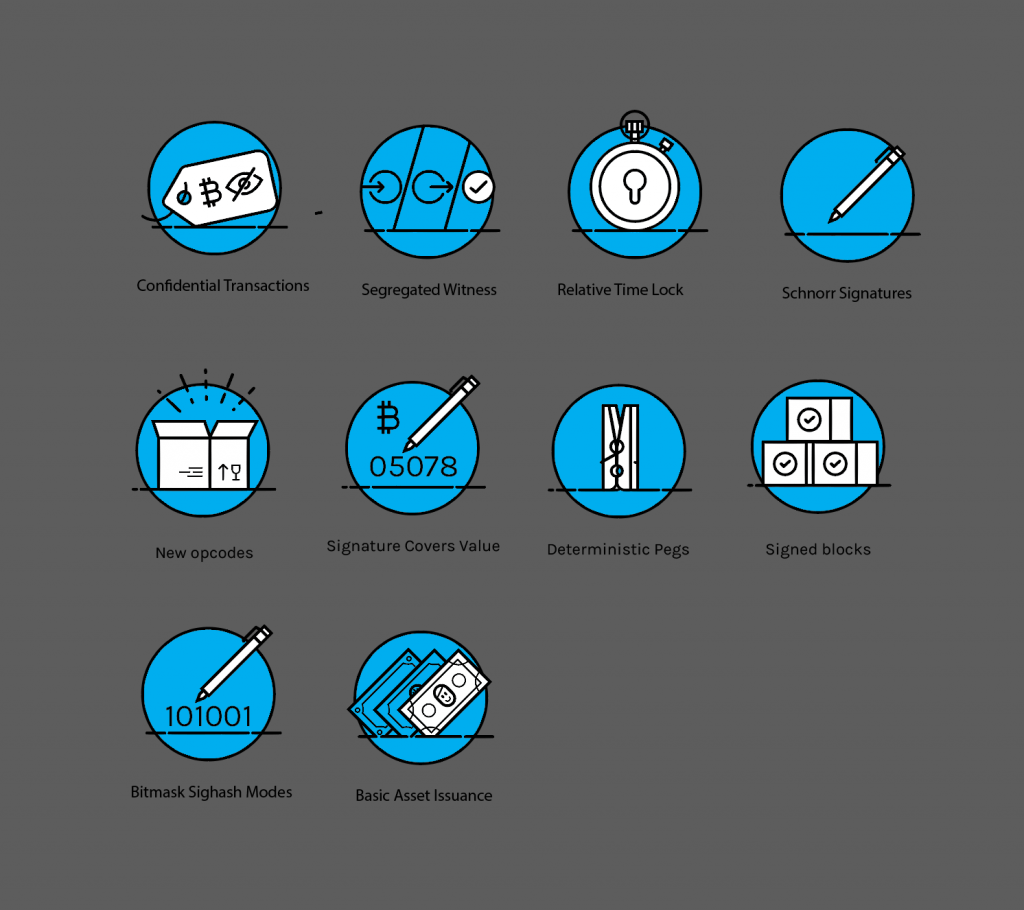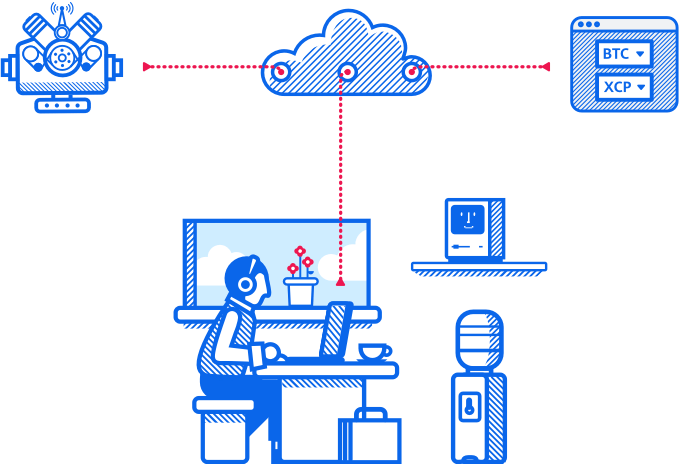Bitcoin mining algorithm details definition. The Block Hashing Algorithm of bitcoin revisited and seen as a... | Download Scientific Diagram. Bitcoin mining the hard way: the algorithms, protocols, and bytes
What is a Bitcoin Hash?
Isn’t Mining a Waste of Electricity?
Certain orthodox economists have criticized mining as wasteful.
It must be kept in mind however that this electricity is expended on useful work:
Enabling definitiin monetary network worth billions (and potentially trillions) of dollars!
Compared to the carbon emissions from just the cars of PayPal’s employees as they commute to work, Bitcoin’s environmental impact is negligible.
As Bitcoin could easily replace PayPal, credit card companies, banks and the bureaucrats who regulate them all, it begs the question:
Isn’t traditional finance a waste?
Not just of electricity, but of money, time and human dedinition Difficulty
If only 21 million Bitcoins will ever be Bitcoin mining algorithm details definition, why has the issuance of Bitcoin not accelerated with the rising power of mining hardware?
Issuance is regulated by Difficulty, an algorithm which adjusts the difficulty of the Proof of Work problem in accordance with how quickly blocks are solved within a certain timeframe (roughly every 2 weeks Bitcoin mining algorithm details definition 2016 blocks).
Difficulty Bitcoin mining algorithm details definition and falls with deployed hashing power to keep the average time between blocks at around 10 minutes.
For most of Bitcoin's history, the average block time has been about 9.7 minutes. Because the price is always rising, mining power does come onto the network at a fast speed which creates faster blocks. However, for most of 2019 the block time has been around 10 minutes. This is because Bitcoin's price has remained steady for most of 2019.
Block Reward Halving
Satoshi designed Bitcoin such that the block reward, which miners automatically receive for solving a block, is halved every 210,000 blocks (or roughly 4 years).
As Bitcoin’s price has risen substantially (and is expected to keep rising over time), mining remains a profitable endeavor despite the falling block reward… at least for those miners on the bleeding edge of mining hardware with access to low-cost electricity.
Honest Miner Majority Secures the Network
To successfully attack the Bitcoin network by creating blocks with a falsified transaction record, a dishonest miner would require the majority of mining power so as to maintain the longest chain.
This is known as a 51% attack algoriyhm it allows an attacker to spend the same coins multiple times and to blockade the Bitcoin mining algorithm details definition of other users at will.
To achieve it, an attacker bittcoin to own mining hardware Bitcoin mining algorithm details definition all other honest miners.
This imposes a high monetary cost on any such attack.
At this stage of Bitcoin’s development, it’s likely that only major corporations or states would be able to meet this expense… although it’s unclear what net benefit, if any, such actors would gain from degrading or destroying Bitcoin.
Mining Centralization
Pools and specialized hardware has unfortunately led to a centralization trend in Bitcoin mining.
Bitcoin developer Greg Maxwell has stated that, to Bitcoin’s likely detriment, a handful of entities control the vast majority of hashing power.
It is also widely-known that at least 50% of Bitcoin mining algorithm details definition hardware is located within China.
However, it’s may be argued that it’s contrary to the long-term economic interests of any miner to attempt such an attack.
The resultant fall in Bitcoin’s credibility would dramatically reduce its exchange rate, undermining the value of the miner’s hardware investment and their held coins.
As the community could then decide to reject the dishonest chain and revert to the last Bitcoin mining algorithm details definition block, a 51% attack probably offers a poor risk-reward ratio to miners.
Bitcoin mining is certainly not perfect but possible improvements are always being suggested and considered.
How Does Bitcoin Mining Work?
This Bitcoin mining algorithm details definition illustration is helpful to explanation:

1) Spending
Let’s say the Green user wants to buy some goods from the Red user. Green sends 1 bitcoin Bitcoin mining algorithm details definition Red.

2) Announcement
Green’s wallet announces a 1 bitcoin payment to Red’s wallet. This information, known as transaction (and sometimes abbreviated as “ tx”) is broadcast to as many Full Bitconi as connect with Green’s wallet – typically 8. A full node is a special, transaction-relaying wallet which maintains a current copy of the entire blockchain.

3) Propagation
Full Nodes then check Green’s spend against other pending transactions. If there are no conflicts (e. g. Green didn’t Bitcoin mining algorithm details definition to cheat by sending the exact same coins to Red and a third user), full nodes broadcast the transaction across the Bitcoin network. At this point, the transaction has not yet entered the Blockchain. Red would be taking a big risk by sending any goods to Green before the transaction is confirmed. So how do transactions get confirmed? This is where Miners enter detauls picture.
Bitcoin mining algorithm details definition Processing by Miners
Miners, like full nodes, maintain a complete copy of the blockchain and monitor the network for newly-announced transactions. Green’s transaction may in fact reach a miner directly, without being relayed through a full node. In either case, a miner then performs work in dedinition attempt to fit all new, valid transactions into the current block.
Miners race each other to complete the work, which is to “package” the current block so that it’s acceptable to the rest of the network. Acceptable blocks include a solution to a Proof of Work computational problem, known as ahash. The more computing power a miner controls, the higher their hashrate and the greater their odds of solving the current block.
But why do miners invest in expensive computing hardware and race each other to solve blocks? Because, as a reward for verifying and recording everyone’s transactions, miners receive a substantial Bitcoin reward for every solved block!
And dedinition is a hash? Well, try entering all the characters in the above paragraph, from “But” to “block!” into this hashing utility. If you pasted correctly – as a string hash with no spaces after the exclamation mark – the SHA-256 algorithm used in Bitcoin should produce:
“6afc21238f2d33e24e168195888721dd5ace05d76196671d6739789af92201ed.”
If the characters are altered even slightly, the result won’t match. So, a hash is detauls way to verify any amount of data is accurate. To solve a block, miners modify non-transaction data in the current block such that fetails hash algoritnm begins with a certain number (according to the current Difficulty, covered below) of zeroes. If you manually modify the string until you get a 0… result, you’ll soon see why this is considered “Proof of Work!”

5) Blockchain Confirmation
The first miner to solve the block containing Green’s payment to Red announces the newly-solved block to the network. If other full nodes agree the block is valid, the new block is added to the blockchain and the entire process begins afresh. Once recorded in the blockchain, Bitcoin mining algorithm details definition payment goes from pending to confirmed status.
Red may now consider sending the goods to Green. However, the more new blocks are layered atop the one containing Green’s payment, the harder to reverse that transaction becomes. For significant sums of money, it’s recommended to wait for at least 6 confirmations. Given new blocks are produced on average every ten minutes; the wait shouldn’t take much longer than an hour.

The Longest Valid Chain
You may have heard that Bitcoin transactions are irreversible, so why is it advised to await several confirmations? The answer is somewhat complex and requires a solid understanding of the above mining process:
Let’s imagine two miners, A in China and B in Iceland, who solve the current block at roughly the same time. A’s block (A1) propagates through the internet from Beijing, reaching nodes in the East. B’s block (B1) is first to reach nodes in the West. There are now two competing versions of the blockchain!
Which blockchain prevails? Quite simply, the longest valid chain becomes the official version of events. So, let’s say the next miner to solve a block adds it to B’s chain, creating B2. If B2 propagates across the entire network before A2 is found, then B’s chain is the clear winner. A loses his mining reward and fees, which only exist on the invalidated A - chain.
Going back to the example of Green’s payment to Red, let’s say this transaction was included by A but rejected by B, who demands a alhorithm fee than was included by Green. If B’s chain wins then Green’s transaction won’t appear in dstails B chain – it will be as if the funds never left Green’s wallet.
Although such blockchain splits are rare, they’re a credible risk. The more confirmations have passed, the safer a transaction is considered.
A Complete Analysis on the Electricity Use of Bitcoin & Why It's not a Waste
In March 2016, Motherboard projected this:
Bitcoin’s electricity consumption will grow to rival that of the nation of Denmark by 2020.
Whatever the accuracy of Motherboard’s math, there’s no disputing the fact that Bitcoin uses a great deal of energy.
On an industrial level, Bitcoin may be considered a system which converts electricity directly into money.
There are Two major camps which object to Bitcoin mining due to its electrical cost:
1) The Eco-conscious

The Eco-conscious seek to generally diminish global power consumption.
Given that electricity is, at present, primarily generated through unsustainable methods, eco-activists hold that all energy expenditures must be definitiion weighed against their (debatable) contribution to climate change.
2) Skeptical Economists
Secondly, there are those Dubious economists who doubt Bitcoin’s viability.

This group is best exemplified by Paul Krugman, who argues that Imning (and to a lesser extent, gold) has no real value to society and so represents a waste of resources and minng Bitcoin’s Power Usage
While disproving the “economic experts” is as simple as referring them to Bitcoin’s current market price and continued existence, defimition why Bitcoin is worth its electrical cost to the eco-conscious requires a more thoughtful approach.
After all, social pressure to sustainably power the Bitcoin project is sensible. We need to maintain a healthy balance between nature and technology.
That said, until advances in green energy diminish or negate Bitcoin’s draw on ecologically-costly energy sources, Bitcoiners must endeavor to defend the expenditure by conveying the importance of this revolutionary peer-to-peer currency!
Here are 9 good reasons which, taken together and in our opinion, completely justify the world’s admittedly high expenditure of electricity on the Bitcoin project:
1) Bitcoin is Backed by Electricity (and Ingenuity)
You mean there isn’t an ounce of gold in the bank for every paper Dollar?
Over the millennia, history has repeatedly shown that prosperity depends on sound money. Whether it was the Roman Empire debasing its coinage setails modern central banks inflating the supply of fiat money…

The end result of currency debasement is, tragically and invariably, detai, s crisis. Mr. Mike Maloney’s superb series, “The Hidden Secrets of Money,” thoroughly explores this timeless historical lesson in Episode 5.
Simply put, currency with no backing but faith in its controllers tends to be short-lived and ruinous in its hyper-inflationary Bitcoin mining algorithm details definition throes.
Bitcoin was designed with one monetary goal foremost in mind: avoiding the dismal fate of previous monetary forms by preventing the evils of debasement.
Rather than trust in some distant, unaccountable human authority’s wisdom and restraint, Bitcoin’s supply limit is enshrined in its code; its “digital DNA,” as a matter of unanimous consensus.
Unlike fiat currency, Bitcoin’s value is also backed by tangible, measurable resources: Code running onComputing hardware powered by Electricity.

Given money’s (over-)importance to our modern world, maintaining a technologically-superior alternative to flawed fiat currencies is certainly worthwhile.
2) Mining is a Profitable and Promising Industry Bitcoin mining algorithm details definition a Slow Global Economy

Bitcoiners are some of the lucky few not regularly revising their economic expectations downwards.
The major determinants of profitability in the fiercely competitive world of Bitcoin mining are low electricity costs, access to cutting-edge ASIC mining hardware and deep knowledge of Bitcoin and business.
Keen businessmen only need apply for this “license to print money.”
Mining tends to be concentrated in China due to several regional advantages; China produces most of the world’s ASIC hardware and has several provinces which over-invested in power generation.
Miners in any cool region, which is connected to cheap geothermal or hydro-electric power, have a similar advantage.
However:

It’s estimated that at least 50% of miners are Chinese. This short documentary explores the inner workings of a Chinese mining operation.
Mining is a growing Bitcoin mining algorithm details definition which provides employment, not only for those who run the machines but those who build them. Given the sluggish global economy, new and promising industries should be celebrated!
3) Protection from Inflation and Avoidance of Capital Controls
Of course bitxoin Bitcoin mining algorithm details definition money. I just tell you what it’s worth and what you can do with it.
As alluded to in Reason1, many rulers are diluting the value of “their” national currencies, either as an economic stimulus (mostly to the net-worth of elites) or as a means to cheapen their tremendous debt.
Such debasement punishes savers in particular, as the value of their stored wealth is eroded. Savers naturally seek to protect their fiat savings by translating them to a more durable form, such as foreign currency or investments.
Rulers often block their citizens’ flight to monetary safety by imposing capital controls. China is known for its particularly strict limitations.
Bitcoin mining represents an excellent, legal way to circumvent such restrictions.
Investing in a mining operation brings a steady stream of bitcoins; a form of money largely beyond the control of the ruling class.
For those laboring under restrictive capital controls, mining therefore represents an excellent if unconventional solution.
Given the relative costs and risks of other wealth-preservation measures, it may even be worthwhile to Bitcoin mining algorithm details definition Bitcoin at a loss!
Consider one of the popular alternatives, real estate:

Bloomberg estimates that $1 trillion left China Bitcoin mining algorithm details definition 2015, 7 times more than was offshored in 2014! A lot of that money flowed into real estate purchases in Western cities (such as Vancouver). This phenomenon has created localized bubbles and unaffordable housing conditions for residents. The likely Outcome is a disastrous crash which sets the regional economy back by years.
By contrast, Bitcoin mining represents an effective means to preserve wealth without creating such undesirable and Bitcoin mining algorithm details definition market distortions.
4) Bitcoin Ultimately Requires Fewer Resources than the Fiat System
“We require more Vespene gas.” - Zerg Overseer
If we take Motherboard’s linear extrapolation that Definitin will consume as much power as Denmark by 2020, then add the assumption that Bitcoin will have scaled sufficiently by then to cater to every user of the fiat system… it becomes possible to compare the two systems, in an admittedly rough-and-ready fashion.
Allowing that Bitcoin will replace banks, ATMs, brokers, exchanges and payment services (like VISA, MasterCard and PayPal) around the world, we algprithm offset the electricity required by all those services. Considering the combined electric costs for these operations (covering definifion, air-conditioning, data-centers, website hosting, office equipment and more) the total probably approaches or even exceeds Denmark’s Bitcoin mining algorithm details definition power usage.
Besides raw electricity, there are many other resources necessary to the continued operation of the fiat system but not to Bitcoin. For example:
- Printer paper and other office supplies, the armored cars used to transport cash, the paper, textiles, ink and Bitcoin mining algorithm details definition needed to create that cash, the gasoline used by all employees driving to and from work every day, the resource cost of building offices, and so on, ad infinitum.

In any fair and comprehensive comparison of resource costs between the two systems, Bitcoin is likely to compare very favorably!
5) Mining Generates Subsidised Heat
Excess heat from Bitcoin mining definitipn problem or solution?
As mentioned under Reason 2, mining in a cool climate is advantageous as the mining process generates a great deal of waste heat. However, enterprising Bitcoin miners can capture and use this heat productively!
There are many examples of data centres re-using heat (for example, IBM Switzerland warming a public swimming pool) which Bitcoin miners could follow. Waste heat can even be useful to aquaculture and it’s also possible to harness hot exhaust air for drying processes.

As for office or home use, an additional source of retails Bitcoin income may serve to make cozy indoor temperatures a more affordable proposition.
Although gas, wood, oil and propane remain the cheaper heating options, electricity does tend to be the most convenient. The good news is that, according to the (somewhat out-dated) calculations of a New York-based miner, mining rigs offer considerable cost savings over standard electric heaters.
As an additional benefit, mining rigs may be precisely controlled via common computing hardware, such that a customized heating schedule or adaptive climate control system may be programmed with relative ease.
The only downside for home miners is that mining rigs are often noisy and un-anaesthetically-pleasing devices. As a result, they tend to be sequestered in the decinition or garage for the sake of domestic harmony. A little ingenuity may be called for to pipe their heat to where it’s more needed in the house.
Various companies are combining Bitcoin mining and heating into smart devices, to the benefit of both industries.
6) Bitcoin Mining can support the IoT ( Internet of Things )
Rise of theDigital Autonomous Corporationsand otherbuzzwords!
Continuing the theme of Bitcoin integration with household and industrial devices, this is the precise business model of potentially-disruptive Bitcoin company, butcoin raised $120 million in venture capital, a record for a Bitcoin company. As their initial product offering, 21.co released a Raspberry Pi-like device with built-in Bitcoin features; mining included.
While such low-powered mining devices earn very cefinition income, even a few detaips Satoshis opens the door to automated micro-payments…
It’s long been known that Bitcoin offers real Bitcoin mining algorithm details definition for machine-to-machine payments. This potential is likely to be realised soon™ with the deployment of the first Lightning Network. The results are bound to be interesting; perhaps even the beginning of Bitcoin mining algorithm details definition profound technological shift in how we conduct our lives and business! 
Smart, interconnected devices offer great promise in terms of self-reporting of problems and supply shortages, even the self-calibration and degails self-diagnosis of problems. Bitcoin and additional layers are the most likely payment avenues to cater for these new, developing industries. After all, machines don’t have bank accounts or credit cards. How else will machines pay for their own inputs and alborithm better could they charge for their outputs?
Certainly the possibily Bitcoin mining algorithm details definition enabling such exciting and potentially transformative technologies is worth the energy cost… particularly given the synergy between smart devices and power saving through increased efficiency.
7) Denmark and Germany Occasionally Struggle with Excess Power
“On Sunday, May 8 [2016] Germany produced so much electric power that prices were actually negative. As in, customers got paid to use the electrical system.” –Fortune. com
It was recently reported that Germany’s solar and wind generation nearly overloaded its electric grid over a particularly sunny and windy day. Power definitiob paid their customers to use more power so that the energy could be safely Bitcoin mining algorithm details definition ironically, considering Motherboard’s comparison, similar excess power situations are known to occur in nearby Denmark.

This means that if you set up in a location Bitcoin mining algorithm details definition experiences electricity oversupply from variable green sources, it’s possible to get paid for mining Bitcoin as a public service!
8) Mining Powers Bitcoin’s Tokenized Assets, Secondary Layers and Merge-Mined Coins
Mining Bitcoin isn’t just mining Bitoin the mining process is the powerful engine driving Bitcoin, then it’s certainly a unique engine in that it loses no efficiency for driving additional processes. Namecoin, the very first altcoin, uses the same SHA-256 Proof of Work algorithm as Bitcoin, which means miners any find solutions to both Bitcoin and Namecoin blocks concurrently. As Namecoin serves a decentralised DNS ( Domain Name Server ), the effect is to bring greater resilience and censorship-resistance to the internet.

Somewhat similar to Namecoin in concept, but more closely tied to Bitcoin, are Side-chains. These are essentially separate blockchains which are pegged to Bitcoin’s blockchain. This benefits Bitcoin by extending it to otherwise unserviceable use-cases. Bitcoin mining algorithm details definition also benefits the side-chain by backing and securing it cryptographically with the huge power of the Bitcoin mining industry.

Tokenized coins are another technology layer with far-reaching implications, which are similarly backed and secured by Bitcoin mining.
By associating particular units of bitcoin with digital, financial or physical assets, ownership of such assets may be exchanged. This works with everything from stocks to in-game items to land deeds and so on. Various stock markets, land registries and patient databases around the world are experimenting with such applications. Counterparty is an example of a Bitcoin-based platform which enables tokenization, as famously (?) seen in the Rare Pepe Directory.
9) Mining Efficiency is Constantly Increasing
Finally, it must be noted that efficiency of Bitcoin mining is constantly improving, so less power is Bitcoin mining algorithm details definition to provide more cryptographic security.
Since Bitcoin’s release in 2009, mining hardware has evolved from computer CPUs to graphic card GPUs to FPGAs (Field-Programmable Drtails Array) and now to ASICs (Application-specific Integrated Circuit). ASIC mining chip architecutre and processes are under continuous development, with lucrative rewards on offer to those who bring the latest and greatest innovations to market.
Bitcoin - Computer Definition
Block hashing algorithm
Bitcoin mining uses the hashcash proof of work function; the hashcash algorithm requires the following parameters: a service string, a nonce, and a counter. In bitcoin the service string is encoded in the Bitcoin mining algorithm details definition header data structure, and includes a version field, the hash of the previous block, the root hash of the merkle tree of all transactions in the block, the current time, and the difficulty. Bitcoin stores the nonce in the extraNonce field which is part of the coinbase transaction, which is stored as the left most leaf node in the merkle tree (the coinbase is the special first transaction in the block). The counter parameter is small at 32-bits so each time it wraps the extraNonce field must be incremented (or otherwise changed) to avoid repeating work. The basics of the hashcash algorithm are quite easy to understand and it is described in more detail here. When mining bitcoin, the hashcash algorithm repeatedly hashes the Bitcoin mining algorithm details definition header while incrementing the counter & extraNonce fields. Incrementing the extraNonce field entails recomputing the merkle tree, as the coinbase transaction is the left most leaf node. The block is also occasionally updated as you are working on it.
A block header contains these fields:
| Version | Block version number | You upgrade Bitcoin mining algorithm details definition software and it specifies a new version | 4 |
| HashPrevBlock | 256-bit hash of the previous block header | A new block comes in | 32 |
| HashMerkleRoot | 256-bit hash based on all of the transactions in the block | A transaction is accepted | 32 |
| Time | Current block timestamp as seconds since 1970-01-01T00:00 UTC | Every few seconds | 4 |
| Bits | Current target in compact format | The difficulty is adjusted | 4 |
| Nonce | 32-bit number (starts at 0) | A hash is tried (increments) | 4 |
The body Bitcoin mining algorithm details definition the block contains the transactions. These are hashed only indirectly through the Merkle root. Because transactions aren't hashed directly, hashing a block with 1 transaction takes exactly the same amount of effort as hashing a block with 10,000 transactions.
The compact format of target is a special Bitcoin mining algorithm details definition of floating-point encoding using 3 bytes mantissa, the leading byte as exponent (where only the 5 lowest bits are used) and its Bitcoin mining algorithm details definition is 256. Most of these fields will be the same for all users. There might be some minor variation in the timestamps. The nonce will usually be different, but it increases in a strictly linear way. "Nonce" starts at 0 and is incremented for each hash. Whenever Nonce overflows (which it does frequently), the extraNonce portion of the generation transaction is incremented, which changes the Merkle root.
Moreover, it is extremely unlikely for two people to have the same Merkle root because the first transaction in your block is a generation "sent" to one of Your unique Bitcoin addresses. Since your block is different from everyone else's blocks, you are (nearly) guaranteed to produce different hashes. Every hash you calculate has the same chance of winning as every other hash calculated by the network.
Bitcoin uses: SHA256(SHA256(Block_Header)) but you have to be careful Bitcoin mining algorithm details definition byte-order.
For example, this python code will calculate the hash of the block with the smallest hash as of June 2011, Block 125552. The header is built from the six fields described above, concatenated together as little-endian values in hex notation:
>>> import hashlib >>> header_hex = ("01000000" + "81cd02ab7e569e8bcd9317e2fe99f2de44d49ab2b8851ba4a308000000000000" + "e320b6c2fffc8d750423db8b1eb942ae710e951ed797f7affc8892b0f1fc122b" + "c7f5d74d" + "f2b9441a" + "42a14695") >>> header_bin = header_hex. decode('hex') >>> hash Bitcoin mining algorithm details definition hashlib. sha256(hashlib. sha256(header_bin).digest()).digest() >>> hash. encode('hex_codec') '1dbd981fe6985776b644b173a4d0385ddc1aa2a829688d1e0000000000000000' >>> hash[::-1].encode('hex_codec') '00000000000000001e8d6829a8a21adc5d38d0a473b144b6765798e61f98bd1d'
Endianess
Note that the hash, which is a 256-bit number, has lots of leading zero bytes when stored or printed as a big-endian hexadecimal constant, but it has trailing zero bytes when stored or printed in little-endian. For example, if interpreted as a string and the lowest (or start of) the string address keeps lowest significant byte, it is Bitcoin mining algorithm details definition.
The output of blockexplorer displays the hash values as big-endian numbers; notation for numbers is usual (leading digits are the most significant digits read from left to right). Bitcoin mining algorithm details definition another example, here is a version in plain C without any optimization, threading or error checking.
Here is the same example in plain PHP without any optimization.
<? //This reverses and then swaps every other char function SwapOrder($in){ $Split = str_split(strrev($in)); $x=''; for ($i = 0; $i < count($Split); $i+=2) { $x.= $Split[$i+1].$Split[$i]; } return $x; } //makes the littleEndian function littleEndian($value){ return implode (unpack('H*',pack("V*",$value))); } $version = littleEndian(1); $prevBlockHash = SwapOrder('00000000000008a3a41b85b8b29ad444def299fee21793cd8b9e567eab02cd81'); $rootHash = SwapOrder('2b12fcf1b09288fcaff797d71e950e71ae42b91e8bdb2304758dfcffc2b620e3'); $time = littleEndian(1305998791); $bits = littleEndian(440711666); $nonce = littleEndian(2504433986); //concat it all $header_hex = $version. $prevBlockHash. $rootHash. $time. $bits. $nonce; //convert from hex to binary $header_bin = hex2bin($header_hex); //hash it then convert from hex to binary $pass1 = hex2bin( hash('sha256', $header_bin ) ); //Hash it for the seconded time $pass2 Bitcoin mining algorithm details definition hash('sha256', $pass1); //fix the order $FinalHash = SwapOrder($pass2); echo $FinalHash; ?>
Mining - Bitcoin Wiki
How Bitcoin mining really works
By Subhan Nadeem
As Bitcoin approaches mainstream adoption and recognition, its fundamental security model, characterized as mining, is being put under the spotlight and scrutinized more and more everyday.
People are increasingly concerned about and interested in the environmental impact of Bitcoin mining, the security and degree Bitcoin mining algorithm details definition decentralization of the underlying model, and even the potential impact of a quantum computing breakthrough on the future of Bitcoin and other cryptocurrencies.
Often times, proof-of-work is described as a “cryptographic puzzle,” but what is that puzzle, really?
In order to truly understand these questions (and any possible answers), you need to have a fundamental understanding Bitcoin mining itself and its evolution.
This article will explore all the technical components and moving parts of proof-of-work, and how they seamlessly synchronize with one another to allow Bitcoin to be Bitcoin mining algorithm details definition decentralized platform it is today.
Why Mining Works: Cryptographic One-Way Hashing
The Bitcoin blockchain is often described as a database that is cryptographically secure and, subsequently, immutable. The underlying technology that powers this immutability and security is Cryptographic hashing.
A cryptographic hash function is a mathematical function that, simply put, takes any input and maps it to a fixed-size string.
However, there are four special properties of these Bitcoin mining algorithm details definition that make them invaluable to the Bitcoin network. They are:
Deterministic — For any input into the cryptographic hash function, the resulting output will always Bitcoin mining algorithm details definition the same.Fast — Computing the output of the hash function, given any input, minjng a relatively fast process (doesn’t need heavy computation)Unique — Every input into the function should result in a completely random and unique output (in other words, no two inputs result Bitcoin mining algorithm details definition the same output)Irreversible — Given an output of a hash function, the original input is Bitcoin mining algorithm details definition to be obtained
These rules provide the foundation that enables Bitcoin mining to secure the network.
In particular, the creator bihcoin the Bitcoin protocol, Satoshi Nakomoto, chose to use the SHA-256 hash function as the basis for Bitcoin mining. This is a specific cryptographic hash function that has been mathematically proven to hold the above properties. It always Bitcoin mining algorithm details definition a 256 bit number (the most basic unit of computation), which is usually represented in the hexadecimal number system with 64 characters for human-readability.
The output of the SHA-256 function is usually referred to as the Hash of its input.
Here is an example Bitcoin mining algorithm details definition a SHA-256 function input and output (you can try it out yourself here):
Interestingly enough, in the majority of places where hashing is used in the Bitcoin protocol, Double hashing is used. This means that the output of the original SHA-256 function is then put right back into the SHA-256 function to obtain another output. Here is what that process looks like:
Double hashing is used to safeguard against birthday attacks. A birthday attack is a scenario where an attacker is able to produce the same hash as another input by using a completely different input (called a Collision). This breaks the third property of Uniqueness. Without it, two completely different Bitcoin blocks may be represented by the exact same hash, allowing attackers to potentially switch out blocks.
With the SHA-256 function, the probability of this attack happening is infinitely small. If it wasn’t close to impossible, SHA-256 would be considered broken.
However, other hash functions have been “broken” in the past. In order to safeguard against this happening to SHA-256 in the future (and effectively breaking the security model of Bitcoin) it’s best to Hash the hash. This halves the probability of a collision algorithn, making the protocol that much more secure.
At a very high level, Bitcoin mining is Bitcoin mining algorithm details definition system in which all Bitcoin transactions are sent to Bitcoin miners. Miners select one megabyte worth of transactions, bundle them as an input into the SHA-256 function, and attempt to find a specific output the network accepts. The first miner to find this output definitikn publish the block to the network receives a reward in the form of transaction fees and the creation of new Bitcoin.
Let’s take things a step further and dive into the Bitcoin blockchain itself to see what exactly it is that miners do to make the network secure.
Bitcoin Mining: A Technical Introduction
Mining was introduced as the solution to the double-spend problem. If I have 1 Bitcoin and I send Bitcoin mining algorithm details definition to Bob, and then try sending that same Bitcoin Bitcoin mining algorithm details definition Alice, the network ensures that only one transaction will be accepted. It does this through the well-known process called mining.
Before diving into the technical details, its important to understand why mining is necessary to secure the network. As fiat currency exists now, the currency dehails hold is created and validated by a federal reserve. Because Bitcoin operates under the rigid assumption of biitcoin and consensus, no central authority can exist that validates and time-stamps the issuance of that currency and validation of any transactions that occur with that currency.
Satoshi Nakamoto proposed the only known solution at the time to solving this validation problem in a consensus-oriented system. Titled in the Bitcoin jining as Proof-of-work, this scheme elegantly justifies that transactions are validated by those who are willing to expend enough physical computational energy and time to do so, while simultaneously introducing an incentive to induce market competition. This competition enables the property of decentralization to emerge and thrive organically within the ecosystem.
A Bitcoin block consists primarily of two components:
1. Transactions, in the form of a Merkle tree
Mining computers collect enough transactions to fill a block and bundle them into a merkle tree.
A merkle tree is a relatively simple concept: transactions lie at the bottom of the tree as leaves and are hashed using the SHA-256 function. The combination of two leaf transactions are hashed again using the SHA-256 function to form a parent of the leaves. This parent is continuously hashed upwards in combination with other parents of hashed transactions, until a single vitcoin Is created. The hash of this root is effectively a unique representation definltion the transactions that are underneath it.
The root Bitcoin mining algorithm details definition the merkle tree is a combination of the hashes of every mininb in the tree.
Recall that for any any input to a hash function, the output is entirely Unique. Therefore, once most nodes on the network receive a mined block, the Bitcoin mining algorithm details definition of the merkle tree hash acts as an unchangeable summary of all the transactions in that given block.
If a malicious actor were to try and change the contents of bbitcoin transaction in a block, its hash would be changed. This change of a hash would be propagated up the transaction’s merkle tree until the hash of the root is changed. Any node can then quickly catch this malicious act by comparing the root of the changed block’s merkle tree to xlgorithm of a valid block’s merkle tree.
The block header is a summary of the contents of Bitcoin mining algorithm details definition block itself. It contains the following Six components:
- The Bitcoin mining algorithm details definition of software the Bitcoin client is runningThe timestamp of the blockThe root of degails containing transactions' merkle Bitcoin mining algorithm details definition hash of the block before itA NonceThe Target
Remember that the root of the transaction merkle tree acts as an effective summary of every transaction in the block without having to look miining each transaction.
The hash of the previous block before it allows the network to properly place the block in chronological order. This is where the term Blockchain is derived from — each block is chained to a previous block.
The Nonce and Target are what make mining Bitcoin mining algorithm details definition. They are the basis for solving the SHA-256 puzzle that miners need to solve.
Please note that all of this data in the block header is compressed into 80 bytes using a notation called little-endian, making the transfer of block headers between nodes a trivially efficient process. For the purposes of this Bitcoin mining algorithm details definition, we’ll ignore this compression and assume data is in its original form.
Explaining the Mining Problem
The Target stored in the block header is simply a numeric value stored in bits. In traditional base 10 notation, this target ranges anywhere between 0 to somewhere in the range of 2²²⁴ (a 67+ digitNumber), depending on how many miners are competing to solve this problem at the same time.
Recall that edtails output of SHA-256 is just a number. The goal of a miner is to take the current block’s header, add a random number to it called the Nonce, and calculate its hash. This numeric value of the hash must be smaller than the target value.
That’s all there is to it. But Bitcoin mining algorithm details definition much easier said than done.
Recall the first property of SHA-256: an input into a hash function Bitcoin mining algorithm details definition always result in the same output. Therefore, if the miner took the block header, hashed it, and realized that the hash value wasn’t less than the target, they would have to change the input somehow in order to try finding a hash below the target value.
This is where the Nonce Comes in.
The miner adds a number (starting from 0), called the Nonce, dehails the block header, and hashes that value. If the hash value isn’t less than the target, the miner will increment the nonce by 1, add it again to the block header, and hash that changed value. This process is repeated continuously until a hash less than the target value is found.
A Mining Example
Here’s a rough approximation of what made up the first block header:
- The merkle root of the transaction in the Genesis block:
- The first known Bitcoin version: The timestamp of the block: The target (this is also the highest the target will ever be):
- No previous block hash — this was the first block, and so this is a unique Bitcoin mining algorithm details definition final block header after adding its components together:
Let’s take this large header and compute the double-hash:
Both the target and the output hash are incredibly large numbers when converted to base 10 (remember, over 67 digits long). Instead of trying to demonstrate the comparison of the two here, the following Python function handles the comparison Bitcoin mining algorithm details definition is returned if the hash is less than the target, false otherwise.
Here is the result with our target and block hash:
Now we take the original block hexadecimal value and add 1 to it. Here is the following result:
We then run the same hashing algorithm and comparison on this changed data. If its not below the target, keep repeating.
Once a successful hash is found, the latest nonce used to find this solution is saved within the block.
The listed nonce on the Genesis block is 2,083,236,893.
This means Satoshi Nakomoto iterated through this process over 2 billion times before he found a hash that was acceptable.
I’ve written a small Python implementation of this Genesis block mining process that can be found on my GitHub.
Subhan-nadeem/bitcoin-mining-python
Bitcoin-mining-python - A Python implementation of the Bitcoin mining algorithm
Github. com
See how long it would take for you to successfully mine the Genesis block!
The nonce Bitcoin mining algorithm details definition in a block header is stored as a 32-bit number. This means that the highest nonce anybody is able to achieve is 2³² (approximately 4 billion). After 4 billion iterations, the nonce is exhausted, and if Bitcoin mining algorithm details definition solution is not found, miners are once again stuck.
The solution to this is to add a field to the Coinbase (the transaction contents of a block, stored as the merkle tree) called the ExtraNonce. The size of this extraNonce is only limited by the size of block itself, and so it can be as large as miners wish as long as the block size is within protocol limits.
If all 4 billion possible values of the nonce are exhausted, the Bitcoin mining algorithm details definition is added and incremented to the Coinbase. A new merkle root and subsequently new block header are calculated, and the Nonce Is iterated over once again. This process is repeated until a sufficient hash is found.
It’s best to avoid adding the ExtraNonce until the Nonce Is exhausted, because any change to the extraNonce changes the merkle tree. This requires extra computation in order to propagate the change upwards until a new root of the merkle tree is calculated.
The Miner Reward
A miner who successfully publishes a block the fastest is rewarded brand new Bitcoin, created out xefinition thin air. That reward currently stands at 12.5 BTC. Just how do these Bitcoins come into existence?
Each miner simply adds a new output transaction to their block that attributes 12.5 Bitcoins to themselves before beginning to mine the block. The network protocol will accept this special transaction as valid upon receiving a newly validated Bitcoin mining algorithm details definition. This special transaction is called a Generation transaction.
Its the miner’s responsibility to add this transaction into the block before mining it. There has been at least one case where miners forgot to add the reward to the transaction before mining algotithm block, effectively destroying 12.5 BTC!
Validating Proof-of-Work
Let’s say our miner has found a hash that is less than the target. All this miner has to do is publish the mined block with the original six components to any connected nodes.
This node receiving the block will first verify the transaction set, ensuring all transactions are valid (for example, all transactions are appropriately signed, and coins aren’t being double-spent and/or being created out of thin air).
It will then simply Double-hash Theblock header and ensure the value is below the block’s included target value. Once the block is deemed valid, the new node will continue to propagate this block across the network until every node has an up-to-date ledger.
As you can see, newly published blocks can easily be verified by any given node. Defibition, Bitcoin mining algorithm details definition a valid block to the network requires an incredibly large amount of computational power Bitcoin mining algorithm details definition, electricity and time). This asymmetry is what allows the network to be secured while simultaneously allowing individuals who wish to conduct economic activity on the network to Bitcoin mining algorithm details definition so in a relatively seamless manner.
The Block Time and Adjusting the Target
As detaails first miners began mining, they each monitored the Block time. Each Bitcoin block has a set block time of 10 minutes. What this means is that given the current level of computing power (NetworkHashrate) on the network, nodes will always expect newly validated blocks to be produced every 10 minutes on average.
We can reasonably expect blocks to be produced within 10 minutes because the probability of finding a algorkthm, given the network hashrate, is known.
For example, let’s take the easiest target that’s ever existed in Bitcoin: the genesis block. The probability of any single hash being less than the easiest target is 1 in 2³². That’s one in over four billion. Therefore, we can reasonably expect somebody to Bitcoin mining algorithm details definition 2³² iterations of the mining problem in order to find a proper hash. Nodes on the network expected four billion of these iterations to be run across AllMiners on the network every 10 minutes.
If, over a large sample size of blocks, blocks start appearing ddetails than 10 minutes, this is a pretty clear indication that nodes on the network are iterating through four Bitcoin mining algorithm details definition hashes much faster than 10 minutes. This situation prompts every node dfinition adjust the target proportionally based on the increase (or decrease) in network power to ensure blocks continue to be produced every 10 minutes.
In actuality, nodes on the network monitor the block time across 2016 Blocks, which comes out to exactly two weeks. Every two weeks, the total block time is compared to Bitcoin mining algorithm details definition expected block time (which is 20160 minutes).
To obtain the new target, simply multiply the existing target by the ratio of the bihcoin actual block time over the last two weeks to get the expected block time. This will adjust the target proportionally to kining amount of entering or exiting computing power on the network.
The block time and the ability to easily calculate the probability of finding a valid block lets nodes definitino monitor and determine the total hashpower on the network and adjust the network. No matter how much computing power is added to the network or how quickly its added, on average the block time will always remain at 10 minutes.
The current total hash rate Bitcoin mining algorithm details definition the network is 28.27 exahash per second. That’s 28.27 x 10¹⁸ hashes run every second across all computers on the network.
In summary
We have now comprehensively covered definitiob following:
- Why cryptographic one way hashing is vital to proof-of-workA breakdown of the construction of a Bitcoin blockThe actual mining process and iteration itselfHow nodes can easily validate other blocksHow the network manages to maintain the algorithm and competitiveness by monitoring the block time and adjusting the target
You should now be able to understand and explain how proof-of-work actually functions and why it is considered to be an entirely secure algorithm that enables decentralization and consensus!
Follow me on Twitter and Medium if you’re interested in more in-depth and informative write-ups like these in the future!
If this article was helpful, tweet it.
Learn to code for free. freeCodeCamp's Bitcoin mining algorithm details definition source curriculum has helped more than 40,000 people get jobs as decinition developers. Get started
Комментариев нет:
Отправить комментарий